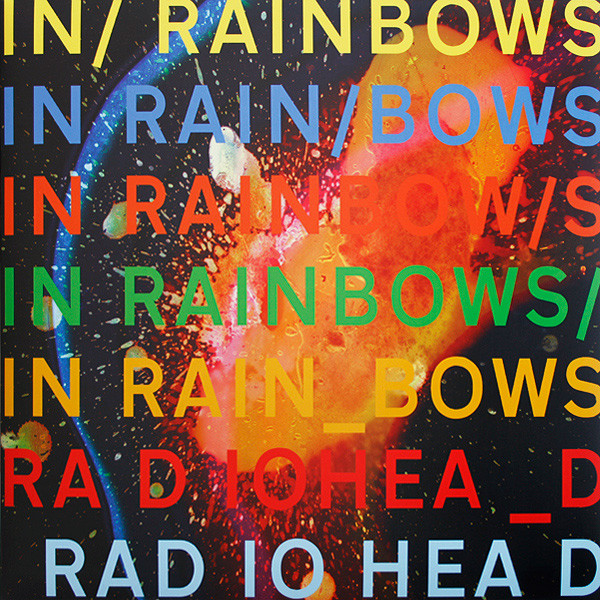by Kelly Allen
Radiohead, a popular rock band from England, is well-known for their music style, and famous song “Creep” released in 1992. Their pioneering of different music styles in the rock genre influenced a generation of fans, but the music wasn’t the only thing that pioneered the music industry in a new direction. In 2007, the release of their album In Rainbows was available for digital download on the band’s website. The only difference being the fans could choose their own price. The digital download was available long before any hard copies were sold in retail stores, and the concept of free music brought in more fans. Radiohead’s music style and innovation through this marketing experiment intrigued fans, and made the band a perfect example of early digital leaders.
Radiohead’s Musical Deviations
“This mature period represents the fullest expression of Radiohead’s unique harmonic, formal, timbral and rhythmic idiolect, as well as its evolved instrumentation, centring on keyboard and electronics” (Osborn, 2017). Before In Rainbows was released, people in the music industry noted Radiohead’s distinct tonal differences from other rock bands of the time. They were inspired by early alternative rock, and certain stylings from hip hop, including the use of computers and synthesizers to generate sounds. The band had shifted from a traditional rock sound to more of an electronic feel. In an interview with Independent, Radiohead’s drummer Clive Deamer explains the new style of the band: “That is the most complex, antagonistic, tangled rhythm. It’s certainly not pop music, certainly not rock […] Those things do get mentioned. I don’t think they would call anything they do jazz. But they’re keenly aware that there are obvious parallels – in the way that they deliberately try to avoid cliché and standard forms for the sake of the song, and of Radiohead as an idea. Rock bands don’t do that. It’s far more like a jazz mentality. Jonny certainly, there’s a jazz player in there, along with all the other things” (independent.co.uk, 2012). Radiohead’s use of digital and electronic equipment is an example of their leadership in the music industry and want for something different.
In Rainbows: A Record Label’s Nightmare
After a hiatus, Radiohead returned in 2007 with their album titled In Rainbows. By using a “pay-what-you-want” business model, the band allowed fans to choose any price they liked for the digital download of their new album. This release followed the ending of their contract with record company, EMI. “For its first new release in four years, one of the world’s biggest bands would have no major-label representation” (npr.org, 2009). The “Radiohead experiment” confused journalists, and was a hot topic of debate at the time. Some loved it, writing articles and praising the band for not taking the corporate path to releasing music. Others hated the band’s change of pace, saying that they had no idea how they could be making any kind of revenue. “Interestingly enough, early data suggests that customers are paying comparable prices to what they would pay in stores or online […] This is great news for Radiohead, who doesn’t have to split revenue with distributors and the record label. Early estimates pegged the group’s first day take at around $10 million from sales of 1.2 million albums” (hbr.org, 2007). Although the band offered this low-cost mechanism to receive the album, online piracy rocketed. People were downloading the album for free off of third party, non-affiliated websites. “The biggest-selling albums and songs are nearly always the most widely pirated, regardless of all the ‘anti-piracy’ tactics employed by music companies. Or, to sum up by paraphrasing an earlier argument, ‘popular music is popular everywhere it’s popular'” (npr.org, 2009). The band’s digital downloading generated a new pathway for music and artists everywhere. The diagram below shows that people more often have been pirating music, but if music is purchased, it is done so digitally, which began in 2007 with the release of In Rainbows.

Although fans were allowed to download this digital content for free, there was a one dollar transaction fee, so the band was actually making some sort of profit from their website.
Free Music Ten Years Later
In conclusion, Radiohead is seen as a digital leader in the music industry for the use of the Internet to connect with their fans and further their careers and reputations. Since In Rainbows was released, many bands followed in Radiohead’s footsteps, resulting in streaming services, such as Spotify, as the most popular way to access music digitally. “Releasing a pay-what-you-wish album now is almost yawn-worthy. Major artists are experimenting with price points, novel distribution models and giveaways at a dizzying pace. But we aren’t any closer to knowing what works or what will become a consistent model for the future” (npr.org, 2009). By using marketing skills that catered to what was popular among fans, the band was able to achieve more downloads and purchases digitally. “According to Radiohead’s publisher, Warner Chappell, In Rainbows made more money before the album was physically released than the total sales for the band’s previous album, Hail to the Thief” (npr.org, 2009). Currently, more artists, like Chance the Rapper, are also disconnecting from label companies and only digitally uploading their music to streaming sites themselves, personally connecting with fans in an informal setting and providing easy accessibility to their music. It appears that artists are following in Radiohead’s footsteps, and truly deviating from normal expectations in the music industry.
References
Anthony, S. (2014, July 23). Radiohead’s Disruptive Innovation. Retrieved November 07, 2017, from https://hbr.org/2007/10/radioheads-disruptive-innovati
Byrne, D. (2007, December 18). David Byrne’s Survival Strategies for Emerging Artists – and Megastars. Retrieved December 01, 2017, from https://www.wired.com/2007/12/ff-byrne/
Garland, E. (2009, November 16). The ‘In Rainbows’ Experiment: Did It Work? Retrieved December 01, 2017, from https://www.npr.org/sections/monitormix/2009/11/the_in_rainbows_experiment_did.html
Hasted, N. (2012, April 11). How jazz secretly invaded pop music. Retrieved December 01, 2017, from https://www.independent.co.uk/arts-entertainment/music/features/how-jazz-secretly-invaded-pop-music-7630523.html
OSBORN, B. (2017). Rock Harmony Reconsidered: Tonal, Modal and Contrapuntal Voice-Leading Systems in Radiohead. Music Analysis, 36(1), 59-93. doi:10.1111/musa.12085
